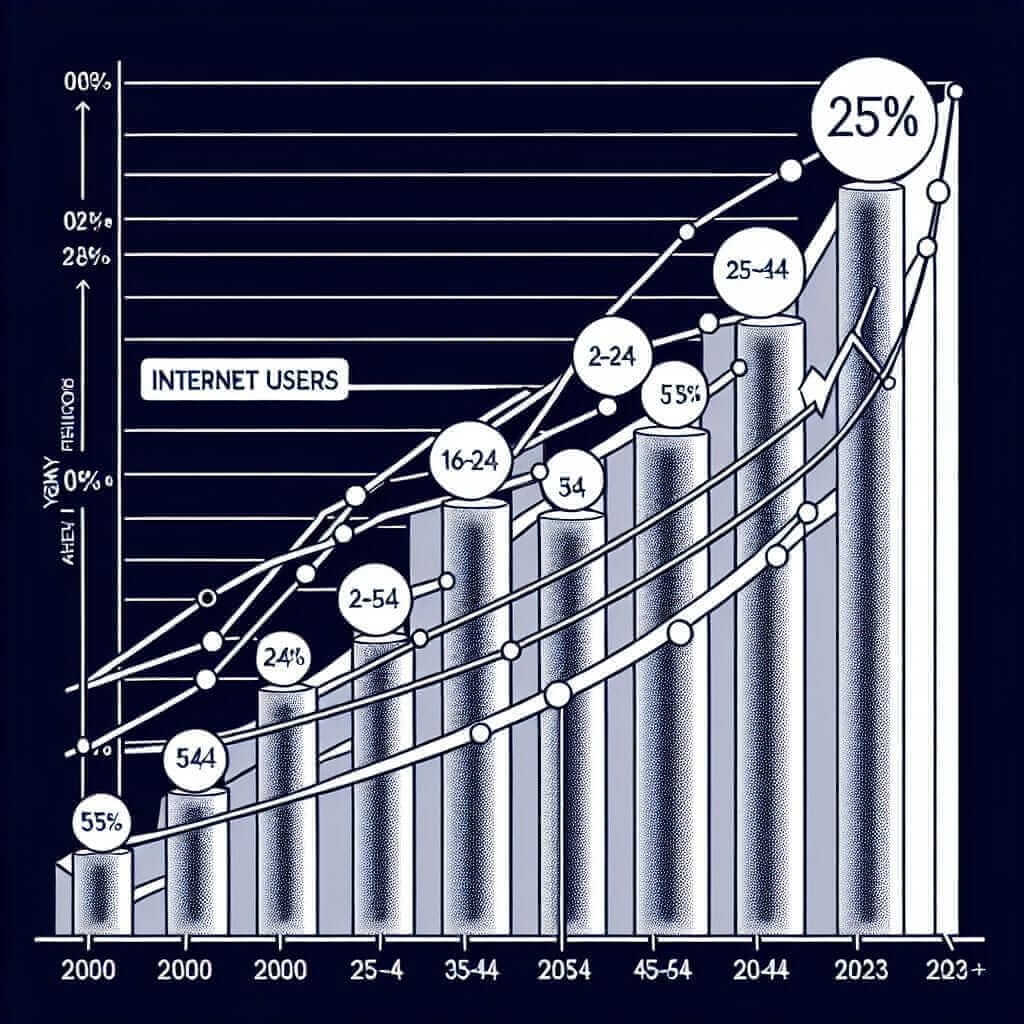The topic of comparing levels of internet usage across different age groups is a common one in the IELTS Writing Task 1. This type of task often involves describing data about how different age demographics have adopted internet usage over time. Given its frequency in IELTS exams, mastering this topic is crucial for achieving a high band score. In this guide, we will create and analyze tasks related to internet usage and provide a detailed sample response, along with essential vocabulary and grammar tips to help you excel.
Nội dung bài viết
Sample Task:
The graph below shows the percentage of internet users among different age groups from 2000 to 2023. Summarize the information by selecting and reporting the main features, and make comparisons where relevant.

Analysis of the Task
When approaching this task, it’s important to:
- Identify key trends: Look for increasing or decreasing patterns over the years.
- Make comparisons: Compare the usage between different age groups.
- Highlight significant data points: Noting years where significant changes occurred.
Key Trends in the Data
From the graph, we can observe the following trends:
- A consistent increase in internet usage across all age groups from 2000 to 2023.
- Younger age groups (16-24) tend to have higher percentages of internet users.
- Older age groups (55+) show slower adoption initially but significant growth in later years.
Sample Essay
Introduction
The line graph illustrates the percentage of internet users in various age groups between the years 2000 and 2023. Overall, there has been a marked increase in internet usage across all age demographics, with younger individuals leading the way in adoption rates.
Overview
From 2000 to 2023, internet usage has witnessed a significant rise among all age groups. Particularly noteworthy is the sharp increase in usage among the 16-24 age group, contrasted with the slower yet steady growth in older demographics.
Body Paragraph 1
In 2000, the age group of 16-24 years old had the highest internet usage at approximately 20%. This figure experienced a steep climb, reaching nearly 95% by 2023. In contrast, the older age groups began with much lower percentages. For instance, the 45-54 age group started at around 10%, but it also saw substantial growth, peaking at about 70% by the end of the period.
Body Paragraph 2
As for the 25-34 and 35-44 age groups, they followed a similar trajectory of rising internet adoption, starting from roughly 15% and 12% respectively in 2000 and soaring to 90% and 80% in 2023. The oldest group, those aged 55 and above, began with minimal usage, around 5%, but saw the most dramatic increase proportionally, ending at 60%.
Conclusion
To conclude, while the 16-24 age group has consistently been the highest in terms of internet usage, significant increases across all age groups highlight the widespread adoption and growing importance of the internet over the years.
Word Count: 240
Key Vocabulary & Grammar
Vocabulary
- Marked increase (n): [mɑːrkt ɪnˈkriːs] – A clear and noticeable rise.
- Adoption rates (n): [əˈdɑːpʃən reɪts] – The speed at which something is taken up by the population.
- Trajectory (n): [trəˈdʒɛktəri] – The path followed by a trend or process over time.
- Proportionally (adv): [prəˈpɔrʃənəli] – In a way that corresponds in size or amount to something else.
- Demographic (n): [ˌdeməˈɡræfɪk] – A specific segment of the population.
Grammar Tips
- Comparative structures: Use phrases like “in contrast,” “compared to,” and “similarly” to make comparisons between different age groups.
- Present perfect tense: Use this tense to describe ongoing trends from the past up to the present (e.g., “internet usage has witnessed a significant rise”).
- Quantifiers: Words like “most,” “many,” and “few” are useful for describing quantities in the data.
By following these strategies, you can effectively tackle any IELTS Writing Task 1 question involving comparisons of internet usage among different age groups. Practice regularly with different data sets to hone your skills and improve your band score.